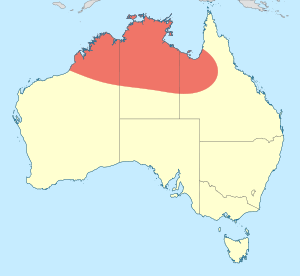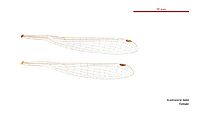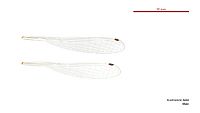Northern pondsitter facts for kids
Quick facts for kids Northern pondsitter |
|
|---|---|
| Conservation status | |
| Scientific classification | |
 |
The northern pondsitter (scientific name: Austrosticta fieldi) is a cool insect that looks a lot like a tiny dragonfly! It's a type of damselfly and belongs to a family called Isostictidae.
This damselfly is found in the Northern Territory of Australia. It loves to hang out near streams, which are like small rivers. The northern pondsitter is a medium-sized damselfly. It's usually a dull grey-brown color with some lighter markings on its body.
Contents
What is a Damselfly?
Damselflies are amazing insects with two pairs of wings. They are often confused with dragonflies, but there are a few easy ways to tell them apart.
- When a damselfly rests, it usually holds its wings together over its back. Dragonflies, on the other hand, often hold their wings out flat to the sides.
- Damselflies are usually smaller and have thinner bodies than dragonflies.
- Their eyes are also different. Damselfly eyes are usually separated and don't touch each other. Dragonfly eyes are often very large and meet in the middle of their head.
Both damselflies and dragonflies belong to a group of insects called Odonata. They are both excellent flyers and important parts of their ecosystems.
Where the Northern Pondsitter Lives
The northern pondsitter calls the Northern Territory in Australia its home. This part of Australia is known for its warm climate and many waterways.
These damselflies prefer to live near streams. Streams provide the perfect environment for them. They need clean water for their young to grow. The plants around the streams also offer places to hunt and rest.
What Do They Eat?
Like most damselflies, the northern pondsitter is a predator. This means it hunts other smaller insects for food.
They are very good at catching flying insects in the air. Their diet often includes tiny flies, mosquitoes, and other small bugs. They use their excellent eyesight and quick flying skills to catch their prey.
Life Cycle of a Damselfly
The life cycle of a damselfly, including the northern pondsitter, is fascinating. It has three main stages: egg, nymph, and adult.
Eggs and Nymphs
Female damselflies lay their eggs in or near water. They often place them on underwater plants. Once the eggs hatch, tiny creatures called nymphs emerge.
Nymphs live underwater. They breathe using special gills. They are also predators, just like the adults. Nymphs hunt small aquatic creatures like tadpoles or insect larvae. They grow by shedding their skin several times. This process is called molting.
Becoming an Adult
When a nymph is ready to become an adult, it crawls out of the water. It usually climbs onto a plant stem or a rock. Then, its skin splits open, and the adult damselfly emerges.
This is a delicate process. The new adult damselfly is soft at first. It needs time for its wings to harden and its colors to fully develop. Once it's ready, it flies off to find food and a mate.
More Pictures




